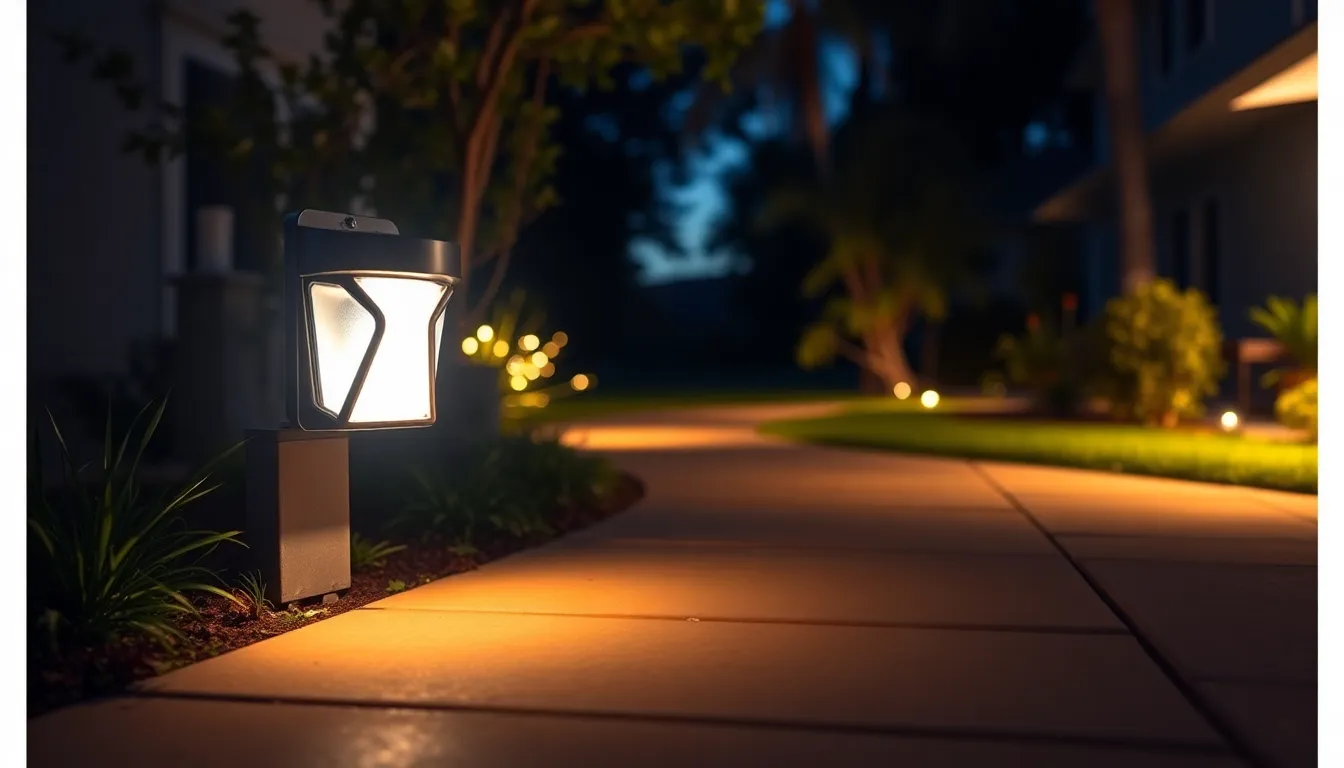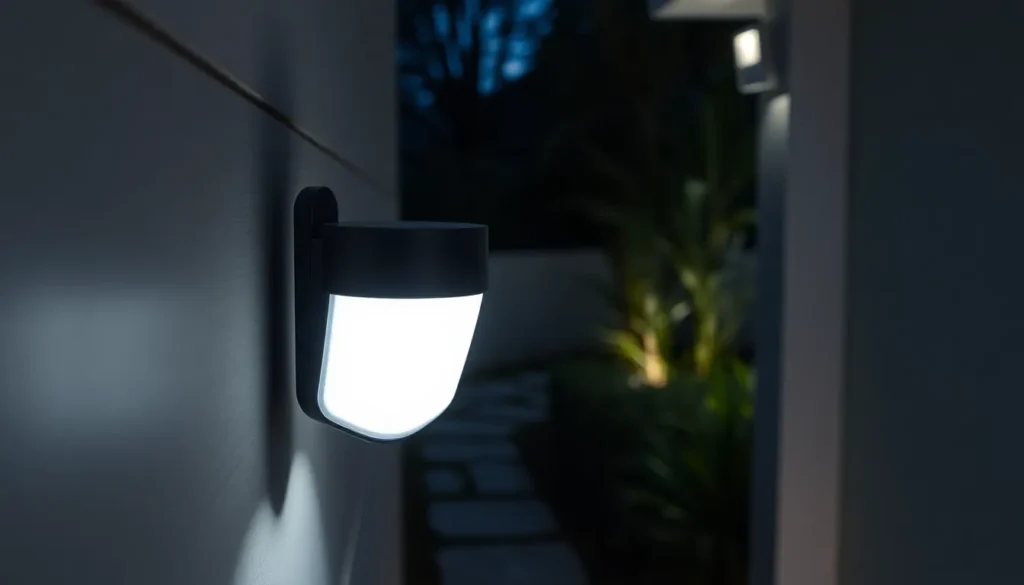Table of Contents
ToggleIn today’s fast-paced world, safety and convenience are more important than ever. Motion sensor lights have emerged as a popular solution for enhancing security around homes and businesses. These innovative devices automatically illuminate spaces when they detect movement, providing peace of mind and energy efficiency.
Not only do motion sensor lights deter potential intruders, but they also offer practical benefits for everyday use. Whether it’s lighting up a dark pathway or brightening a garage, these lights adapt to various environments. As technology advances, the features of motion sensor lights continue to evolve, making them a smart choice for anyone looking to improve their property’s safety and functionality.
Overview of Motion Sensor Lights
Motion sensor lights activate automatically upon detecting movement in their vicinity. These devices use infrared sensors to recognize heat emitted by people and animals, ensuring accurate activation. Many models feature adjustable sensitivity settings, allowing users to customize activation ranges based on specific needs.
Applications of motion sensor lights include outdoor pathways, driveways, garages, and indoor areas such as hallways and staircases. For instance, outdoor installations enhance safety by illuminating dark spaces, deterring potential intruders. Indoor placements help prevent accidents by lighting up previously dim areas when someone approaches.
The technology behind motion sensor lights continues to evolve. Solar-powered models now offer eco-friendly options, reducing electricity costs and promoting sustainability. Smart motion sensors integrate with home automation systems, allowing users to control lights remotely via smartphones or voice commands.
In addition to security and energy efficiency, motion sensor lights can enhance ambiance. Decorative models allow homeowners to select colors and brightness levels, contributing to the overall aesthetic of a space. Overall, motion sensor lights represent a versatile solution for improving safety, convenience, and energy management in various settings.
Types of Motion Sensor Lights

Motion sensor lights come in various types, each serving specific needs and environments. The primary categories include passive infrared sensors, ultrasonic sensors, and dual technology sensors, each with unique features and applications.
Passive Infrared Sensors
Passive infrared sensors detect changes in heat emitted by individuals or animals. These sensors use a pyroelectric sensor to identify movement within a predefined zone. Adjustments for sensitivity and range make these sensors versatile for outdoor applications like pathways and driveways. They typically offer reliable performance during nighttime and low-light conditions, contributing to energy efficiency as they remain inactive until movement is detected.
Ultrasonic Sensors
Ultrasonic sensors utilize high-frequency sound waves to detect motion. These sensors emit ultrasonic waves that reflect off objects and return to the sensor, evaluating the time interval to identify movement. Ultrasonic sensors excel in detecting motion through obstacles, making them suitable for indoor environments, such as hallways and staircases. They provide a broader coverage area and can activate lights even with minor movements, which enhances security and safety.
Dual Technology Sensors
Dual technology sensors combine both passive infrared and ultrasonic technologies to improve detection accuracy. These sensors require both heat and sound wave detection before activating the light, minimizing false triggers. Ideal for areas with varying movement, dual technology sensors are often used in high-security situations or places where reliability is critical. Their combined approach reduces the likelihood of missed detections and ensures consistent performance, enhancing overall safety.
Benefits of Motion Sensor Lights
Motion sensor lights offer significant advantages, primarily in security and energy savings. These benefits contribute to making homes and businesses safer and more efficient.
Enhanced Security
Enhanced security is a key benefit of motion sensor lights. These lights activate upon detecting movement, offering immediate illumination that deters potential intruders. The presence of light acts as a visual barrier, making properties less attractive targets. Proper placement along pathways, entrances, and driveways increases safety for residents and guests. Additionally, integrated smart technology can send alerts to homeowners’ devices when movement is detected, allowing for real-time monitoring and response.
Energy Efficiency
Energy efficiency stands out as another substantial benefit of motion sensor lights. Since these lights activate only when needed, they reduce energy consumption significantly. Many units feature adjustable sensitivity and timer settings, ensuring lights remain off during periods of inactivity. This efficient operation leads to lower electricity bills and a reduced environmental footprint. Solar-powered models further enhance energy efficiency by tapping into renewable resources, providing a cost-effective, eco-friendly lighting solution.
Factors to Consider When Choosing Motion Sensor Lights
Choosing the right motion sensor lights involves assessing multiple factors to ensure optimal functionality and performance. Pay attention to specific elements like detection range, lumens and brightness, and weather resistance.
Detection Range
Detection range determines how effectively a motion sensor light identifies movement. Most models offer detection ranges between 30 to 100 feet. Factors affecting detection include the sensor type and positioning. For outdoor installations, select lights with a longer range to cover larger areas, such as driveways and yards. For indoor settings, shorter ranges suffice, commonly between 10 to 30 feet. Adjustable sensitivity settings can help customize the active range according to the environment.
Lumens and Brightness
Lumens measure light output and brightness, playing a crucial role in illuminating spaces effectively. Typical motion sensor lights range from 300 to 1,500 lumens. For functional spaces like pathways and garages, choose lights with higher lumens to ensure visibility during nighttime. For ambiance, lower lumen outputs suffice in areas like patios or gardens. Consider adjustable brightness options, which allow for flexible illumination settings based on individual needs.
Weather Resistance
Weather resistance is vital for outdoor motion sensor lights, as exposure to elements like rain, snow, and extreme temperatures can affect performance. Look for lights with an Ingress Protection (IP) rating, preferably IP65 or higher, indicating resistance to dust and water. Additionally, materials should demonstrate durability against corrosion and fading caused by sunlight, ensuring longevity and consistent functionality in varying weather conditions.
Installation and Maintenance Tips
Installing motion sensor lights involves several straightforward steps. First, choose the appropriate location to maximize their effectiveness. Areas like doorways, driveways, and walkways are ideal. Second, ensure the surface is clean and dry before installation. Third, follow the manufacturer’s instructions for mounting. Most models come with a bracket; secure it firmly and align the light unit properly. Use a level tool to ensure the light faces the desired direction.
Wiring is an essential aspect for wired models. Proper electrical connections must ensure safety and functionality. If handling electrical work, it’s wise to turn off the power supply beforehand. For solar models, placement should consider sunlight exposure for optimal performance.
Maintenance of motion sensor lights requires minimal effort. Regularly check the sensor lens for dirt, dust, or cobwebs, as these can affect sensitivity. Cleaning the lens with a soft cloth once a month keeps the sensor functioning properly.
Inspect the light bulbs for any signs of dimming or flickering; replace them as needed. For solar options, check the solar panel for debris and ensure it remains clear to harness sunlight effectively. Replacing batteries in battery-operated units can enhance performance, typically every six months or as specified.
Adjusting sensitivity settings can optimize performance. High sensitivity may trigger false activations from animals or passing vehicles, while low sensitivity could fail to detect movement on the property. Finding the right balance ensures reliable functionality. Performing these maintenance tasks will extend the lifespan and efficiency of motion sensor lights.
Motion sensor lights are an essential addition to modern safety and convenience. Their ability to automatically illuminate spaces not only enhances security but also promotes energy efficiency. With advancements in technology these lights are becoming smarter and more versatile. Homeowners and businesses can choose from various types and features to suit their specific needs.
When selecting motion sensor lights it’s crucial to consider factors like detection range and weather resistance. Proper installation and maintenance further ensure these devices operate effectively. As motion sensor lights continue to evolve they represent a practical solution for creating safer and more efficient environments. Embracing this technology can lead to significant improvements in both safety and energy management.




